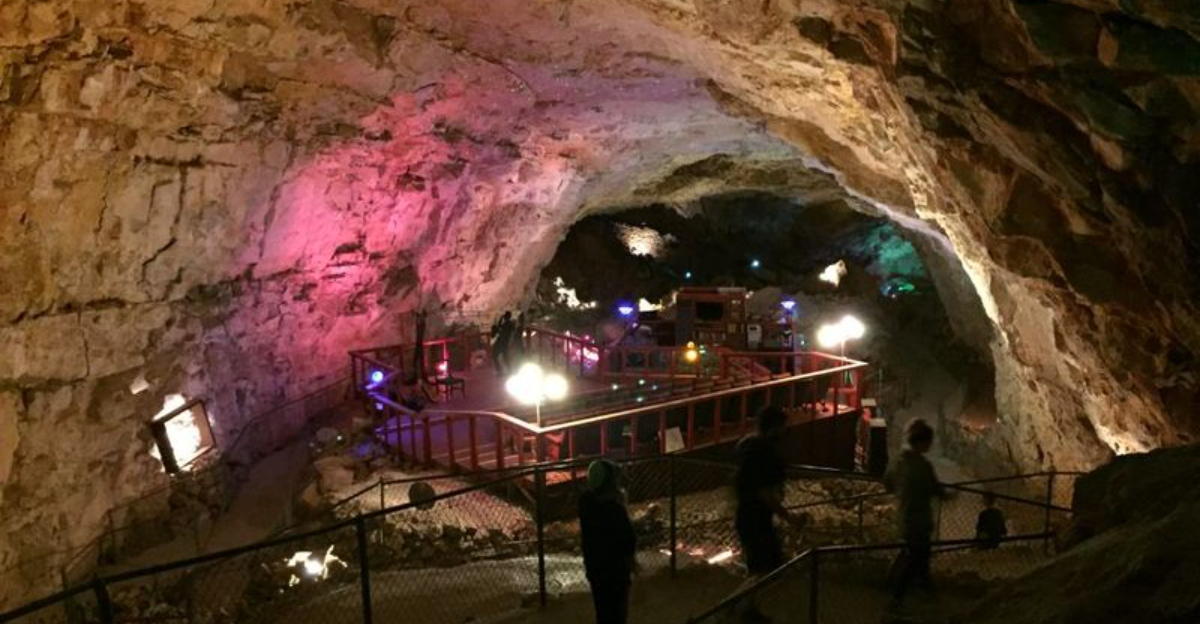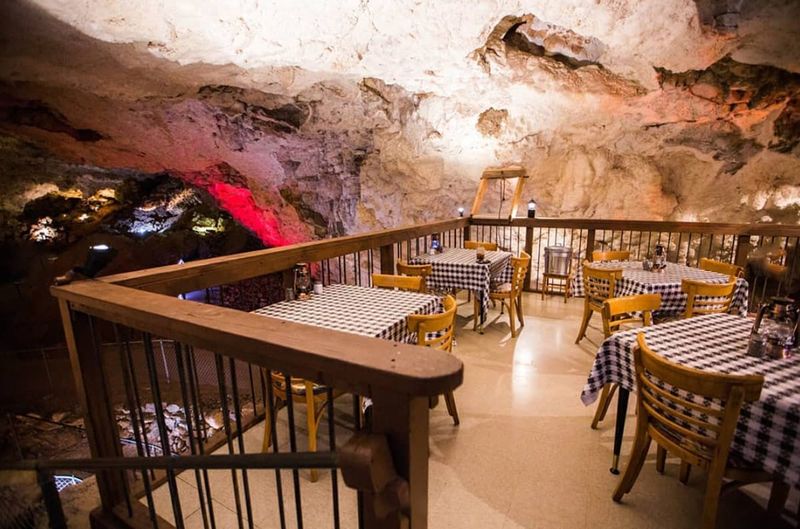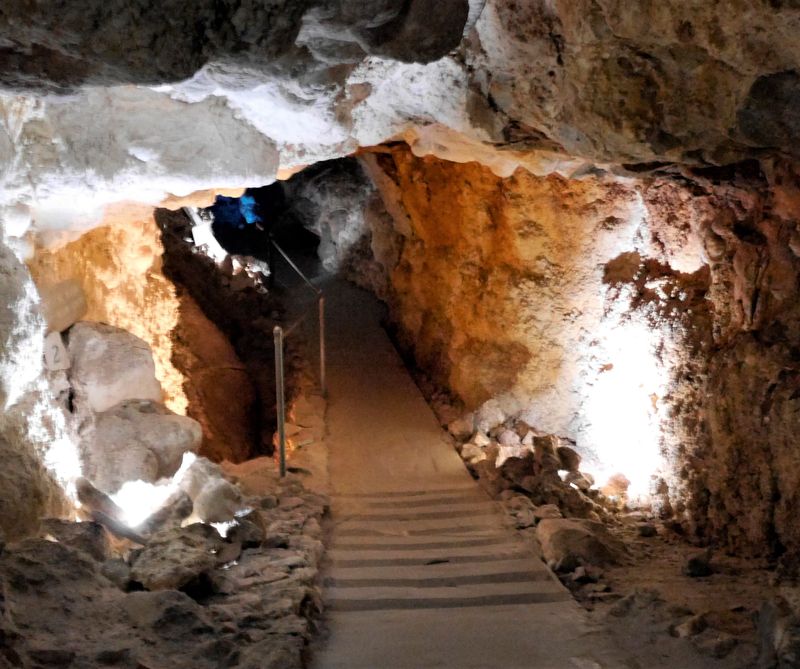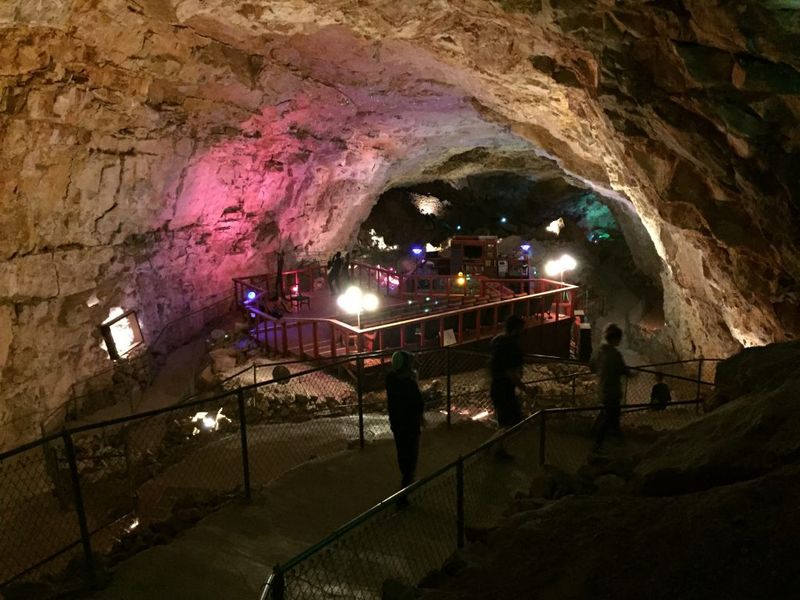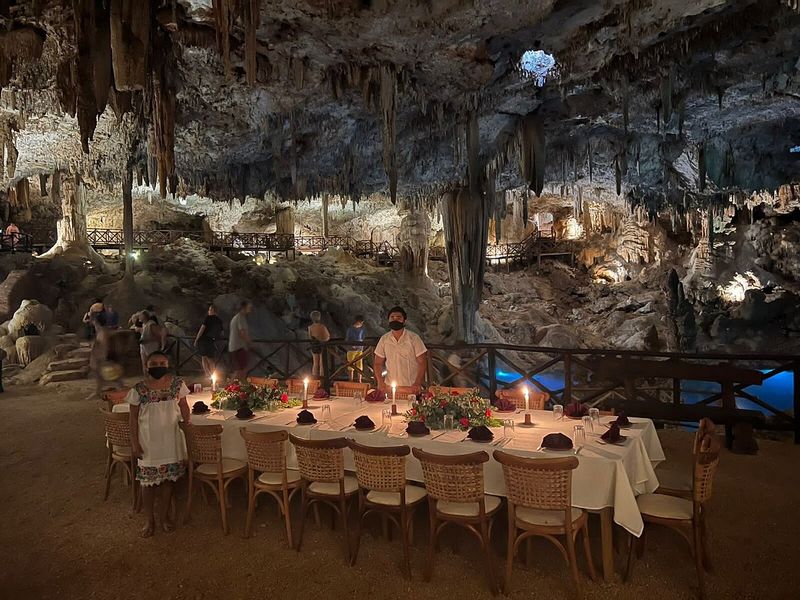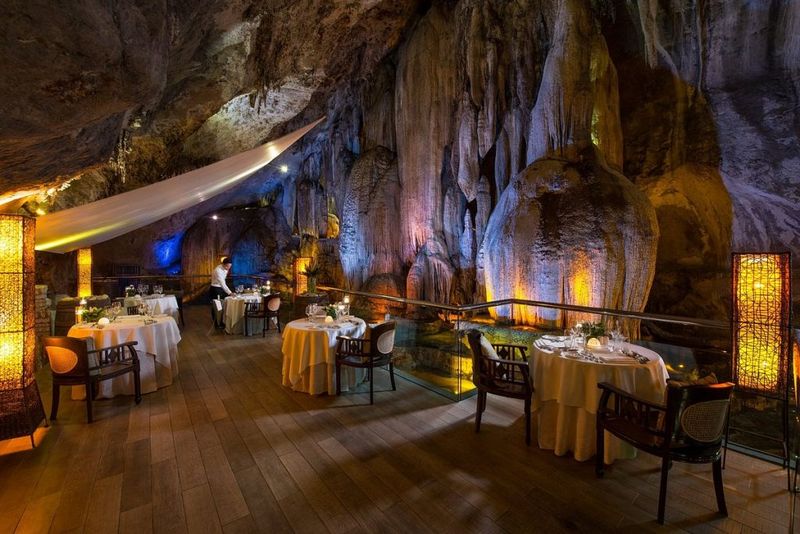Imagine eating dinner 200 feet below the earth’s surface, surrounded by ancient limestone walls that formed over 345 million years ago. The Caverns Grotto in Arizona offers exactly that—a restaurant hidden deep inside the Grand Canyon Caverns system where only a handful of guests can dine at once. This isn’t just a meal with cave-themed decorations; it’s a genuine journey into geological history combined with fine dining. From the elevator ride down to the silent, cool air of the chamber, every moment feels like stepping into another world entirely.
A Dining Experience 200 Feet Underground
Near Peach Springs, Arizona, along the legendary Route 66, lies an entrance to something extraordinary. Guests board an elevator that drops them approximately 21 stories straight down into the heart of a 345-million-year-old cave system. The descent itself becomes theater—lights fade, air cools, and anticipation builds with every foot traveled downward.
Once the doors open, diners step onto a wooden platform surrounded by genuine limestone chambers. There’s no fake rock or plastic stalactites here. The walls tell stories from eons past, shaped by ancient seas and geological forces beyond imagination.
Silence wraps around visitors like a blanket. Natural acoustics carry whispers across stone, and the stillness feels almost sacred. This isn’t dining with a view—it’s dining within the view itself, where nature provides all the ambiance anyone could need.
Limited Seating, Elevated Artifice
Exclusivity reaches new heights—or rather, depths—at the Caverns Grotto. Only four tables fit inside the chamber, meaning just a handful of lucky diners experience this marvel during any given service. Reservations fill up quickly, sometimes months in advance, as word spreads about this geological gem.
Chefs prepare every dish above ground in a full kitchen. Then comes the interesting part: meals travel down via elevator and pulley system, arriving fresh at the cave’s dining platform. It’s a logistical ballet that few restaurants ever attempt.
Background music? Nonexistent. Ambient noise? Practically zero. Instead, natural cave acoustics dominate, creating an atmosphere unlike any typical restaurant. One visitor described it perfectly: cave eating at its finest, where geology becomes the ultimate dining companion.
Geological and Historic Context
The Grand Canyon Caverns rank among America’s largest dry cave systems—no underground rivers or dripping water, just vast chambers carved by ancient forces. These limestone passages formed hundreds of millions of years before dinosaurs walked the earth. Standing inside them puts human history into humbling perspective.
Walter Peck stumbled upon this underground wonderland in 1927 while prospecting for gold. He found something far more valuable than precious metal—a natural treasure that would captivate visitors for generations. Over the decades, the caverns served various purposes, including Cold War fallout shelter planning.
This layered history adds depth beyond novelty. Diners aren’t just eating underground; they’re sitting inside a space that witnessed prospectors’ dreams, wartime fears, and countless geological epochs. Every meal comes with a side of profound history.
Visiting Details and Practicalities
Planning a visit requires advance thinking. Reservations aren’t just recommended—they’re absolutely essential given the four-table limit. Pricing reflects the experience’s rarity, with lunch and dinner options that typically include cavern tours as part of the package. Think of it as paying for both a meal and a journey through time.
Temperature underground stays consistently cool year-round, hovering around 56 degrees Fahrenheit. Smart visitors dress in layers, bringing jackets even during Arizona’s scorching summer months. Comfortable walking shoes help too, since exploring involves navigating uneven cave floors.
The complex above ground offers additional options for those not ready to descend. Standard dining, hotel accommodations, and regular cave tours provide alternatives. But nothing quite matches the magic of eating where ancient seas once flowed.
Why It’s More Than a Meal
Novelty alone doesn’t explain why the Caverns Grotto resonates so deeply with visitors. Something more profound happens when people break bread beneath millions of years of geological history. Time scales shift dramatically—suddenly, restaurant opening hours seem laughably insignificant compared to the eons surrounding every bite.
This space represents multiple human stories layered atop natural history. Walter Peck’s prospecting dreams, Route 66 travelers seeking adventure, Cold War planners imagining survival scenarios—all these narratives intersect underground. Guests become temporary characters in an ongoing saga that spans human ambition and geological permanence.
Eating here prompts reflection in ways surface restaurants rarely achieve. The mundane falls away, replaced by wonder and perspective. It’s dining as meditation, tourism as transformation, and cuisine as connection to something far larger than ourselves.
The Journey Down Into Darkness
Stepping into that elevator marks the beginning of transformation. Metal doors close, and the descent begins—21 stories straight down through solid rock. Stomachs flutter slightly as the lift drops, carrying passengers away from sunlight and into earth’s embrace. Children press faces against walls, adults grip railings, everyone shares nervous excitement.
Darkness intensifies with each passing second. Artificial lights inside the elevator car seem increasingly precious as natural light disappears completely. The mechanical hum of cables and pulleys provides the only soundtrack, a modern sound threading through ancient space.
When the elevator finally stops and doors slide open, the temperature shift hits immediately. Cool cave air rushes in, carrying that distinctive mineral smell of underground places. First-time visitors often pause, taking a moment to absorb the reality: they’re standing deeper underground than most people ever venture.
Silence as the Ultimate Luxury
Modern life drowns us in constant noise—traffic, music, conversations, notifications, machinery. The Caverns Grotto offers something increasingly rare: genuine silence. No playlist curated by algorithms, no clinking dishes from neighboring tables, no street sounds filtering through windows. Just stillness, broken occasionally by quiet conversation or the clink of silverware on china.
Natural acoustics work differently underground. Voices carry with unusual clarity across stone surfaces, yet somehow don’t feel intrusive. Whispers travel surprisingly far, making every exchange feel intimate and intentional. Diners find themselves speaking more softly, listening more carefully, savoring not just food but also the absence of auditory chaos.
This silence becomes its own course, perhaps the most memorable part of the entire experience. Many guests report feeling more present, more connected to their dining companions, more aware of flavors and textures when background noise vanishes completely.
Where Ancient Geology Meets Modern Cuisine
Plating a gourmet meal against a backdrop of 345-million-year-old limestone creates striking contrasts. Delicate sauces and artful arrangements seem almost fragile next to stone that survived countless ice ages, continental shifts, and mass extinctions. Yet somehow, the pairing works beautifully—human creativity honoring natural majesty.
Chefs face unique challenges preparing for cave service. Every ingredient must survive the elevator journey without compromising quality. Temperature-sensitive items require special handling, timing becomes crucial, and presentation must withstand transport. It’s culinary problem-solving at its finest, demanding both skill and creativity.
The result? Dishes that taste somehow more significant when consumed in such extraordinary surroundings. A perfectly seared steak or delicate dessert becomes more than sustenance—it’s proof of human ingenuity, our ability to create beauty and comfort even in the most unexpected places.
